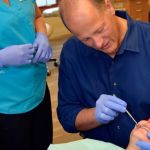
Best Practices for Preventing Tooth Decay in Adults
- 1. Understanding Tooth Decay in Adults
- 2. Essential Oral Hygiene Practices
- 3. Lifestyle Changes for Tooth Decay Prevention
- 4. Regular Dental Checkups and Professional Cleanings
- 5. Dietary Habits and Their Impact on Tooth Decay
- 6. The Role of Fluoride in Preventing Cavities
- 7. How to Choose the Right Dentist for Tooth Decay Prevention
- 8. Conclusion and Next Steps
1. Understanding Tooth Decay in Adults
Tooth decay is not just a problem for children—it can affect adults as well. As we age, our risk of tooth decay can increase due to various factors, such as dry mouth, receding gums, and changes in our diet. Understanding the causes of tooth decay is the first step in preventing it.
For instance, Sarah, a 45-year-old professional, noticed increased sensitivity in her teeth but didn’t realize that her snacking habits and occasional neglect of flossing were contributing to the issue. Tooth decay in adults often starts with minor symptoms, so it’s crucial to be aware of how lifestyle choices affect your oral health.
2. Essential Oral Hygiene Practices
Maintaining a consistent oral hygiene routine is the foundation of preventing tooth decay. Brushing your teeth at least twice a day with fluoride toothpaste, flossing daily, and using mouthwash can significantly reduce your risk of cavities. These practices help remove plaque, a sticky film of bacteria that leads to tooth decay.
James, who struggled with tooth decay in his 30s, began brushing and flossing more rigorously after receiving advice from his dentist. His regular visits helped him realize that, while he brushed regularly, he wasn’t flossing enough, which led to plaque buildup between his teeth. After adding flossing into his routine, his oral health significantly improved.
3. Lifestyle Changes for Tooth Decay Prevention
Your daily habits play a significant role in preventing tooth decay. For example, avoiding tobacco products, reducing sugary food intake, and staying hydrated can all help maintain good oral health. Smoking and excessive alcohol consumption contribute to dry mouth, which can accelerate decay, while sugary foods create an ideal environment for bacteria that cause cavities.
When Mark, a regular soda drinker, started cutting back on sugary drinks, he noticed a decline in his cavities. His dentist suggested that limiting sugary snacks and switching to water instead of soda could reduce the acid attacks on his enamel, helping to prevent tooth decay.
4. Regular Dental Checkups and Professional Cleanings
Even with diligent brushing and flossing, regular dental checkups are essential for long-term oral health. Professional cleanings help remove tartar buildup that can’t be removed with a toothbrush, and regular exams allow your dentist to catch potential issues before they become serious.
For example, Linda had been visiting her dentist twice a year for routine checkups. During her last visit, her dentist detected early signs of enamel erosion. Thanks to the early diagnosis, Linda received preventive care that helped her avoid more severe tooth decay and costly treatments.
5. Dietary Habits and Their Impact on Tooth Decay
Your diet plays a significant role in preventing tooth decay. Foods rich in calcium, vitamin D, and phosphorus are excellent for your teeth, while acidic and sugary foods can increase your risk. Drinking water instead of sugary drinks and choosing healthy snacks like fruits, vegetables, and nuts can support your oral health.
Amy, who used to snack on candy and chips regularly, switched to eating fresh fruit and nuts between meals after consulting with her dentist. This change in her diet helped lower her sugar intake and provided essential nutrients for her teeth, significantly reducing her risk of cavities.
6. The Role of Fluoride in Preventing Cavities
Fluoride is a powerful tool in the fight against tooth decay. It helps strengthen tooth enamel, making it more resistant to decay-causing acids. Using fluoride toothpaste and drinking fluoridated water can provide additional protection for your teeth.
For instance, when Mark switched to a toothpaste with higher fluoride content, he found that his tooth sensitivity decreased, and his cavities stabilized. His dentist recommended fluoride treatments as part of his regular visits, which provided an extra layer of protection against decay.
7. How to Choose the Right Dentist for Tooth Decay Prevention
Choosing a dentist who emphasizes preventive care is key to maintaining optimal oral health. Look for a dentist who not only treats cavities but also educates patients on how to avoid them. Regular checkups and personalized advice are essential for preventing tooth decay.
If you’re looking for a dental professional who prioritizes prevention, visit Dentistry Toothtruth at Dentistry Toothtruth to learn more about how to keep your smile healthy and prevent cavities.
8. Conclusion and Next Steps
Preventing tooth decay in adults is entirely possible with the right practices. By focusing on good oral hygiene, lifestyle adjustments, regular dental visits, and a healthy diet, you can significantly reduce your risk of cavities. Start implementing these best practices today to ensure that your teeth stay healthy for years to come.
For more tips and expert advice on preventing tooth decay, visit Dentistry Toothtruth and schedule your next dental checkup today. Your smile will thank you!







 Associated Orthodontists - Joliet4.0 (132 review)
Associated Orthodontists - Joliet4.0 (132 review) Elegant Dentistry, Brett Sperry DMD5.0 (3 review)
Elegant Dentistry, Brett Sperry DMD5.0 (3 review) Smile Central Dental4.0 (506 review)
Smile Central Dental4.0 (506 review) Stahl Dental Studio4.0 (36 review)
Stahl Dental Studio4.0 (36 review) Oradell Family Dental4.0 (138 review)
Oradell Family Dental4.0 (138 review) Day and Night Dental5.0 (68 review)
Day and Night Dental5.0 (68 review) The Importance of Oral Health Education During Pregnancy for a Healthy Pregnancy
The Importance of Oral Health Education During Pregnancy for a Healthy Pregnancy Best Tips for Brushing Your Teeth Properly for Healthy Gums: Essential Techniques for Oral Health
Best Tips for Brushing Your Teeth Properly for Healthy Gums: Essential Techniques for Oral Health Why Skipping Dental Checkups Can Lead to Bigger Oral Health Problems
Why Skipping Dental Checkups Can Lead to Bigger Oral Health Problems Advantages of Porcelain Dental Restorations
Advantages of Porcelain Dental Restorations How Can Diabetes Cause Tooth and Gum Problems? Preventing and Managing Oral Health Issues
How Can Diabetes Cause Tooth and Gum Problems? Preventing and Managing Oral Health Issues Healthy Habits for Promoting Good Oral Health and Hygiene: Tips for a Healthy Smile
Healthy Habits for Promoting Good Oral Health and Hygiene: Tips for a Healthy Smile